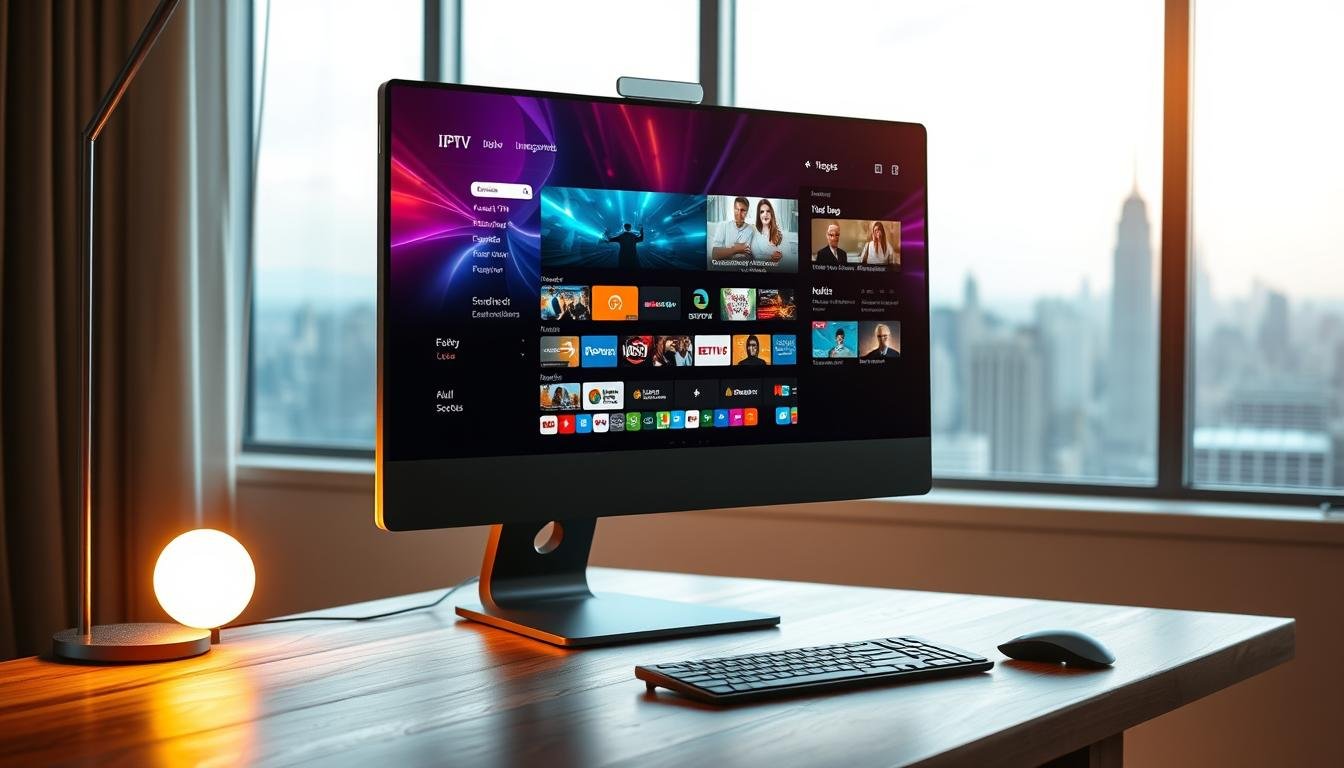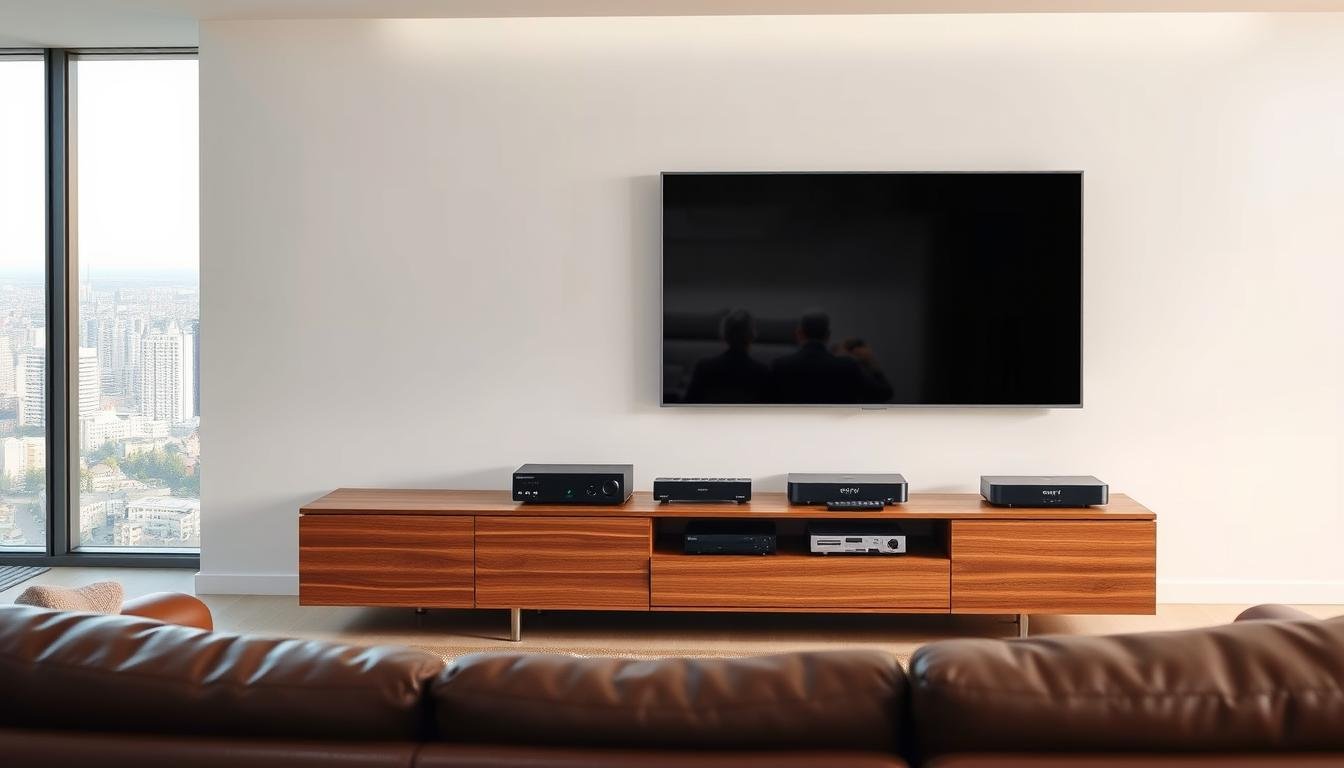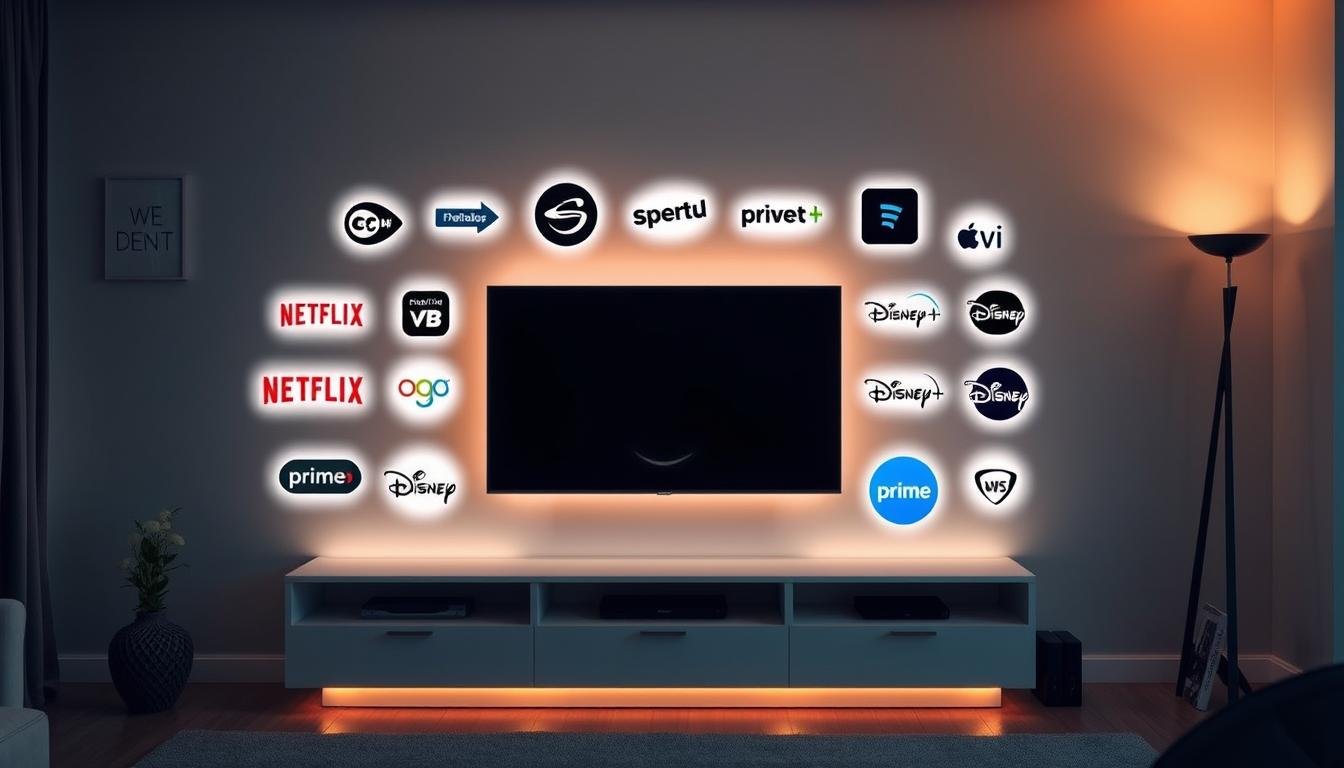Table of Contents
Imagine watching Strictly Come Dancing live, then switching to a crime drama box set – all without changing devices or waiting for downloads. Sounds like telly magic? That’s the reality of modern internet protocol television services reshaping how Brits consume media.
Gone are the days of rigid schedules and clunky aerials. Today’s viewers demand flexibility, and traditional broadcasting struggles to keep up. Internet-based television bypasses satellite dishes and cables, delivering programmes straight to your smartphone, tablet, or smart telly through your broadband connection.
But how does it actually work? Like your favourite streaming platforms, this technology uses internet protocols to transfer data. The difference? It combines live broadcasts with on-demand libraries, letting you choose exactly what to watch and when. No more missing episodes because you’re stuck in traffic or fancy a late-night film marathon.
Over 60% of UK households now use online streaming services weekly. Yet many remain unaware they could replace their entire TV package with something more adaptable. From skipping adverts to pausing live sport, the control shifts to your fingertips.
Ready to explore how this innovation could simplify your viewing routine? Let’s break down why internet-delivered content is becoming the new normal – and whether it’s time your household joined the revolution.
Introduction to IPTV Technology
Television’s transformation over the years feels like swapping a black-and-white set for 4K streaming. Remember when Saturday nights meant adjusting rabbit-ear aerials? Today’s viewers juggle live sport, box sets anWhat is IPTV? Breaking Down the Basicsd cat videos – all thanks to internet protocol advancements reshaping media distribution.

Understanding Television in the Digital Age
Your telly habits have changed more than you realise. Traditional cable and satellite systems once ruled living rooms, beaming programmes through physical cables or dishes. Now, broadband connections handle the heavy lifting. High-speed internet allows seamless delivery of HD content, video-on-demand libraries and interactive features – no more waiting for weekly episodes.
The Evolution from Cable and Satellite to IPTV
Those clunky satellite dishes gathering moss? They’re becoming relics. Modern services bypass physical infrastructure entirely, using data packets sent through fibre-optic networks. This shift means instant access to global channels and pauseable live broadcasts. You’re no longer tied to broadcast schedules – just your Wi-Fi password.
Why does this matter? Cable and satellite providers can’t match the flexibility of internet-based systems. Whether you’re binge-watching dramas or catching up on news, your broadband connection becomes the ultimate entertainment hub. The telly revolution isn’t coming – it’s already here.
What is IPTV? Breaking Down the Basics
Your telly’s gone digital – but not in the Freeview sense. Protocol television uses your broadband to deliver programmes through internet networks rather than satellite signals. Think of it as your telly having a direct chat with the web.

Traditional broadcasts push content one-way like a megaphone announcement. Internet protocol television creates a conversation – your device requests specific video content, servers send it instantly. This two-way street enables features traditional telly can’t match:
- Pause live football during tea breaks
- Rewind news segments you missed
- Internet-based television bypasses satellite dishesAccess box sets without extra subscriptions
You’ll need three things: a decent broadband connection, compatible devices (smart TVs, tablets, set-top boxes), and a streaming service subscription. Unlike satellite dishes, these systems adapt to your habits – suggesting shows based on what you binge-watch.
The real game-changer? Video quality adjusts automatically if your Wi-Fi wobbles. No more pixelated penalty shootouts during broadband hiccups. Whether you’re queueing at Tesco or lounging at home, your content follows seamlessly across gadgets.
How IPTV Works: From Set-Top Boxes to Streaming Devices
Press play on your next binge-watch, and hidden tech springs into action. Behind every streamed episode lies a clever dance between your internet connection and clever hardware. Let’s peel back the curtain.
Decoding the Streaming Process
Your “watch now” command kicks off a digital relay race. Here’s how it unfolds:
- Your device sends a request to content servers
- Video gets chopped into data packets using internet protocols
- Signals zip through fibre cables to local network nodes
- Your set-top box or smart telly decodes the data
This entire journey happens faster than boiling your kettle. No satellite dishes required – just a sturdy broadband connection.
The Role of Internet Connection and Devices
Your viewing experience hinges on two factors: streaming hardware and broadband speed. Older tellies need set-top boxes like Amazon Fire Stick to translate internet signals. Modern smart TVs handle this internally.
For buffer-free viewing, aim for at least 25Mbps speeds. HD content demands more bandwidth than making a cuppa requires hot water. Slow connections? You’ll face pixelated faces during crucial plot twists.
Popular devices include:
- Roku sticks (plug-and-play simplicity)
- Apple TV (seamless iOS integration)
- Built-in smart TV apps (no extra box needed)
Choose gear matching your tech comfort – whether you’re a gadget whizz or just want telly that works.
Exploring IPTV Services and Provider Benefits
Choosing your telly lineup used to mean settling for packages crammed with channels you’d never watch. Modern IPTV services flip the script, letting you handpick content like a Netflix queue meets live broadcasting. Whether you’re after rugby matches or reality shows, providers put you in the director’s chair.
Service Flexibility and Content Options
Leading service providers like YouTube TV and Hulu + Live TV ditch rigid bundles. Fancy 80+ channels with unlimited cloud recordings? Done. Prefer saving quid with Sling TV’s basic sports package? Sorted. These platforms blend live broadcasts with box sets, often letting three devices stream simultaneously.
Top perks include:
- Swapping channels monthly without exit fees
- Adding movie platforms like NOW TV mid-subscription
- Watching on your commute via 4G/5G
Legal Considerations and Reliability
Not all providers play by the rules. Stick to licensed services like BT TV or Virgin Media to avoid dodgy streams. Legit platforms invest in proper bandwidth – crucial for buffer-free FA Cup finals.
When vetting IPTV services, check:
- Ofcom accreditation
- Transparent pricing (no hidden “premium” charges)
- 24/7 customer support
Reliable providers like Sky Glass guarantee 99% uptime, meaning you’ll rarely miss a kickoff. Pair that with fibre broadband, and you’ve got telly that adapts to your life – not the other way round.
IPTV Formats: Live TV, Video on Demand and NVOD Explained
Your telly schedule just got a personality transplant. Modern viewing formats let you boss around programmes like a Netflix director with live audiences. Whether you crave real-time drama or late-night film binges, these options cater to every whim.
Live Broadcasts and Time-Shifted Viewing
Fancy watching Match of the Day live while pausing for pizza deliveries? Live broadcasts stream in real-time but add clever tricks traditional telly can’t match. Services like BBC iPlayer let you rewind goals or skip ad breaks mid-programme.
Missed Love Island? Time-shifted viewing keeps shows available for 7-30 days. No need for recorders – your broadband becomes a personal TV archivist. Catch-up platforms store episodes automatically, saving you from spoiler-filled WhatsApp groups.
NVOD: An Alternative to Traditional Scheduling
Near Video on Demand works like cinema showings for your sofa. New films start every 15 minutes across multiple channels. Perfect for blockbuster nights when you’re fashionably late.
Sky Cinema uses this format for premieres, letting you join movies at convenient times. It’s ideal for group viewings where mates arrive with crisps at different intervals. You control the schedule without waiting for weekly slots.
These formats blend seamlessly in modern services. Watch live football, then switch to Peaky Blinders box sets – all within the same app. Your telly adapts to your life, not the broadcaster’s clock.
Pros and Cons of IPTV: Weighing Your Options
Your telly habits deserve proper scrutiny before jumping ship from traditional broadcasting. Modern internet protocol services offer tempting freedoms, but savvy viewers weigh both perks and pitfalls.
Advantages of Internet Protocol Television
Ditch the aerial and embrace control. These systems let you customise viewing like never before:
- Watch live rugby matches or Bake Off repeats on trains, tablets or tellies
- Access content libraries rivalling Netflix’s catalogue
- Pause live broadcasts during loo breaks without extra gadgets
4K streaming and Dolby Atmos sound become reality with decent broadband. Many services like Sky Stream even suggest shows based on your binge patterns.
Potential Challenges and Considerations
Not all that glitters is gold. Your experience hinges on broadband reliability – subpar connections cause pixelated nightmares during penalty shootouts. Legal grey areas lurk too: stick to Ofcom-approved providers to avoid copyright headaches.
Other snags include:
- Premium subscription tiers costing more than licence fees
- Device limits blocking simultaneous football and cartoons
- Complex setups for technophobes
Choose wisely – legitimate options balance quality and convenience without breaking laws or the bank.
Setting Up Your IPTV Experience: Tips and Considerations
Your living room’s about to become a command centre for telly domination. Start by matching your viewing habits with the right service provider and hardware. Whether you’re after 4K football or Strictly reruns, these steps ensure seamless streaming without the tech headaches.
Choosing the Right Service Provider
Not all IPTV services deliver equal bang for your quid. Prioritise providers with Ofcom accreditation and transparent pricing. Check if they support your smart TVs or require a set-top box – Amazon’s Fire Stick remains a popular plug-and-play option.
Optimising Your Network Connection
A stable internet connection is non-negotiable. Use Ethernet cables instead of Wi-Fi for 4K streaming on main TVs. Position routers centrally and upgrade to fibre broadband if HD buffers during peak hours. Most services need 25Mbps – test yours before subscribing.




